Cobalt Kinetics Evolve
As I mentioned in the previous press release last week, I had been invited to a media day to preview a new “AR platform” rifle concept that Cobalt Kinetics will be bringing to SHOT, and will also begin producing and selling next year. A number of you readers brought some good observations that I will hopefully be able to address in this article.
Really their performance enhancements, to date, have made sense for the competition realm (whether or not top level competitors will buy an “off-the-shelf” build is irrelevant, the design was based around those concepts). This new creation, however, has some modifications that definitely have some utility in other professions and venues.
Disclosure: I was invited to the event with a number of other media entities and industry folks; Cobalt Kinetics did cover expenses.
Construction
So, the initial disclaimer is that this platform is currently in a “beta” state. It is certainly not finalized and there is a little tweaking that it still needs prior to SHOT, and eventually sale.
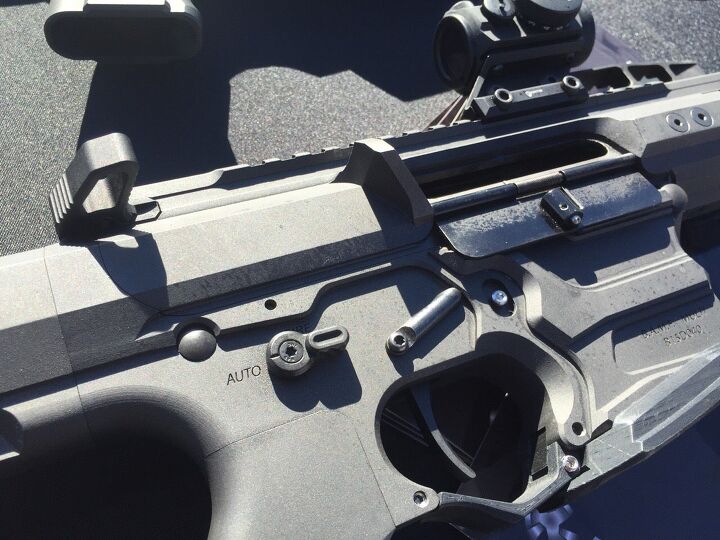
Where is the forward assist?
The versions that were available for the demo were their “competition” (semi-auto) and “select fire” models. The overall appearance has what is the very distinctive Cobalt Kinetic look. It possesses aggressive lines and metallic finish–the rifles we shot were blue and “crushed silver” (and there is rumor that Cobalt Kinetics is going to “bring black back”). The one immediately noticeable difference between this and the BAMF (and Edge) lines is that they have smoothed out the forward picatinny rails (you can see pics from my post on the BAMF; the rails came to a pretty sharp point). The uppers also were missing their “Double-D” feature—in fact there was not even a regular forward assist (so all of you that hate the forward assist, This may be your Huckleberry).
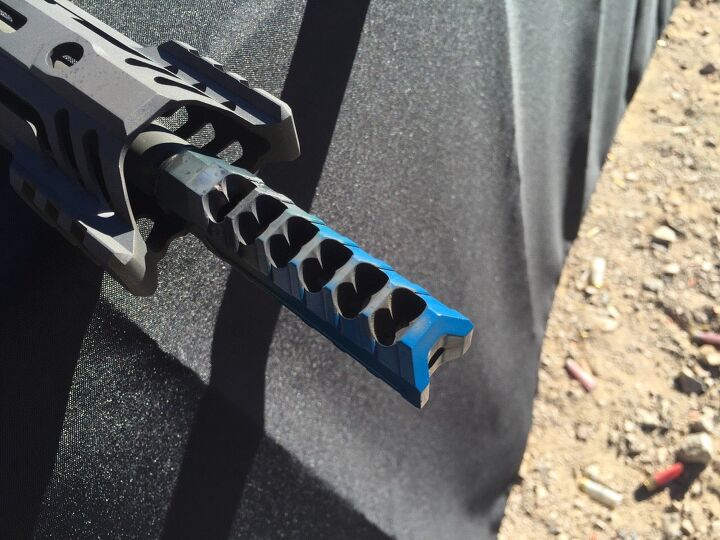
The select fire version nastied up the blue Evolve Comp after a few thousand rounds.
Despite the above, the uppers are not what this demo was about. The new features and system are all part of the lower, which is named C.A.R.S. (for Cobalt Advantage Reload System; there may, or may not, have been a previous code name for the technology which may, or may not, be hilarious and certainly not for polite company). The new two new features that the C.A.R.S. brings are the automatic magazine ejection and the automatic bolt drop and lock-back.
The magazine ejection is a surprisingly obvious concept once you see it. Basically there is a small lever mounted at the top of the magazine well that is triggered when the follower in your empty magazine makes contact with it. You can see it operating in the following video.
As the lever is actuated it actually also traps the bolt behind it, using the new “bolt catch”. And when you insert a fresh magazine, this same mechanism is what “drops” the bolt.
Another really cool feature is that locking back the bolt is entirely one handed operation. You do not have to engage the bolt drop button. Simply pulling the charging handle rearward will lock the bolt in place (so long as there isn’t a loaded magazine inserted into the weapon). Similarly the bolt will not automatically go forward when an empty magazine is inserted.
They have also made improvements to the buffer system, allowing for easy end-user customization. The spring itself is sheathed in a press-fitted laminated tube, and there are a couple of options for springs based on whether or not you are running a rifle or carbine version. The weight itself is easy to modify by popping off an end cap (rather than punching out roll pins, or just buying a new weight) and swapping out for one of three variants based on the weight you are trying to set: full steel, half steel/half tungsten, or full tungsten. Also, rather than a nylon/plastic pad, they have gone with a highly absorptive rubber that eliminates pretty much all of the impact force.
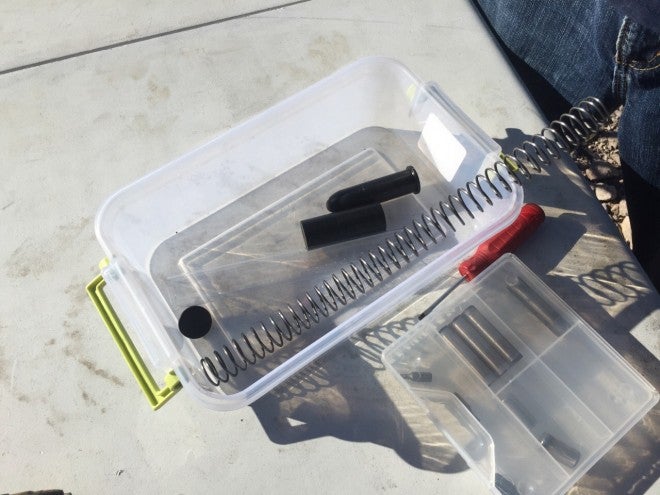
All of the buffer components. Of course in this picture the laminated tube is hard to see…
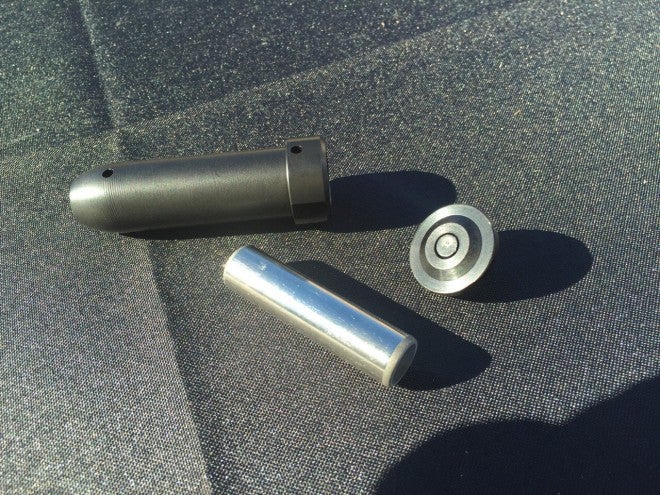
Buffer weight disassembled.
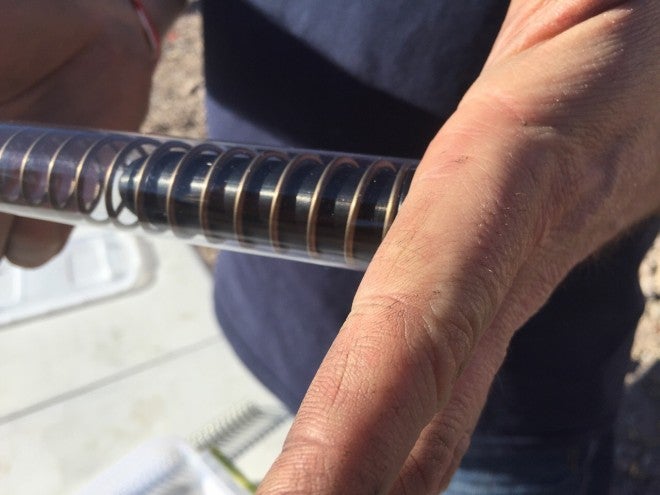
How the buffer assembly looks.
The final addition to their product is a new muzzle device. Yeah, yeah, I know. Everyone and their elderly grandmother has produced a muzzle device at this point. Well, this one performs. This specific compensator does not have any top ports (which seems to have become a recent trend). Instead the gases vent completely to the sides.
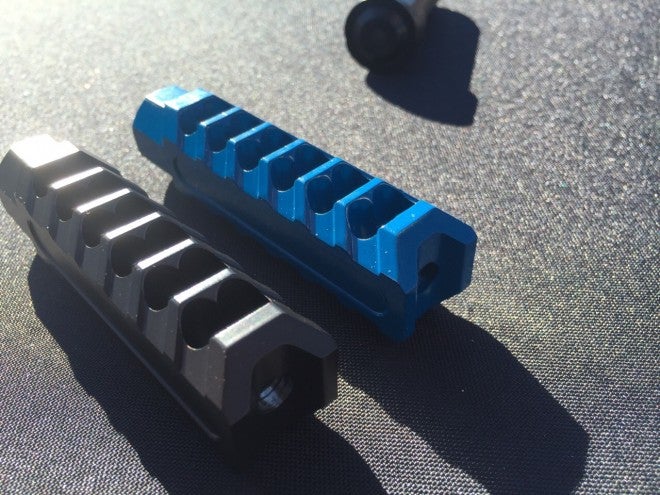
The Evolve Comp
A couple of modifications that are already in the works are an ambidextrous magazine release button and extended bolt drop button. They were not ready for the demo rifles we fired but should be in place at SHOT.
Observations
I did my best to take some clear video so that you readers could form your own opinions about the form and function of this rifle. That said, I will layout my opinion based on my handling of the Evolve, as well as what I was able to observe from the other media that were in attendance.
Okay, so the new features… Pretty cool. I spent most of my time firing the select fire version (the mechanical aspect of the C.A.R.S. behaved the same between the semi-auto and select fire versions).
One of the pretty impressive demonstrations was firing the rifle on full auto. The new muzzle device (that they are calling the “Evolve Comp”) did an unbelievable job of stopping muzzle rise. And it did not annoy the crap out of everyone around either. The night before the shoot, they showed off some videos with Kristie O (who is maybe 100 lbs soaking wet with a lead vest on) running the rifle full auto without any discernible muzzle creep. It was duplicated at the range (thank you Mike Searson for modeling for me).
Keeping in mind these are beta versions of the rifle, they performed admirably. We did have a couple of issues with the bolt not locking back when the empty magazine was ejected (which did eject correctly, and as anticipated, when it was empty). Dave Lake, their Head Gun Smith, quickly identified that the issue was related to the well-worn 30 round PMags we were using. The variance in the manufactured tolerances of magazines is the one problem area that this rifle (still in beta, remember) currently possesses. Basically it is a timing issue. The magazine has to drop far enough out of the magazine well for the actuator to catch the bolt. With a mag that is a bit slower “out of the gate” (due to friction from size, etc.) the bolt catch is not deployed and the bolt continues forward. It will be interesting to see how this component is affected by dirt and other grime that could add friction to the system. That said, we were running pretty dirty magazines since they were all auto ejecting to the ground. Really they have engineered a precision mechanism that probably needs to be a bit sloppier… 🙂
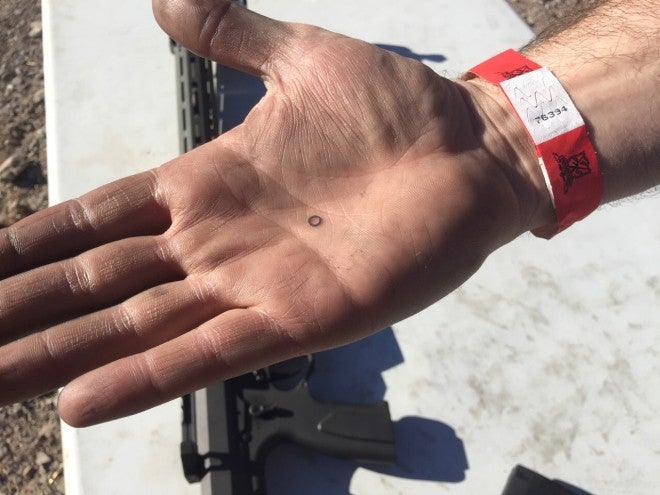
One of the spacers in the C.A.R.S. that is used for adjustment.
Cobalt Kinetics’ goal is to have it working well for the most common magazines in the wild, and they will have an adjustment kit (basically some spacers for the C.A.R.S.) which will allow for fine tuning to accommodate that variability. The system does run flawlessly using high end HK mags, mainly because they are manufactured with pretty tight tolerances. And while I can already hear the grumbling in the comments about this, most of us are magazine snobs—we generally run one brand of magazine and that is that. It is a fallacious argument that most ARs will run all magazines in existence without issues—a “fact” which someone once tried to convince me; never believe in absolutes… 🙂
Keith Garcia, veteran police officer and 3-Gun competitor, was brought on board to assist with some of the design and function direction, especially related to the more utilitarian, non-competition, version (I’m trying to come up a term other than “tactical”). He demonstrated some of the concepts for clearing malfunctions, including clearing a double feed one handed which you can see in the below video:
Watching the above demonstration in person definitely sold me. If you have ever had to clear a double feed, I think you can appreciate the above. Note that he inserted an empty magazine at the end; a full magazine would have chambered a round and sent the bolt home, making the weapon ready to go again.
Questions and Answers
I had asked you readers to post questions and concerns in the press release I put out, and boy did you (though not actually as many as I expected). Most of the questions were pretty legit (given the 400 pixel wide rendered image and limited details I had for the article). I did my best to get answers for each of them.
I “reworded” a number of the questions/concerns, and also attempted to clarify what I thought some of you were asking (using my ever growing “snark” filter). I also attempted to give credit to the commenter where is was fairly unique (though a number of you had similar posts). I apologize if I left anyone’s name out—let me know in the comments and I’ll amend the article.
Will this be available in a phased plasma rifle/Star wars blaster version?
Not yet, but maybe in few years… 🙂
Does it have a normal bolt release?
No it does not have a “normal” bolt release since the catch mechanism is completely different, but it does have an external button which functions as a bolt release.
Does it have a normal magazine release
Yes, and it will also be ambidextrous.
Can the automatic functions be disabled?
Short answer is yes. Over simplifying the mechanics, there is a cam that can be positionally “locked”, effectively disabling either the automatic magazine release or the auto bolt drop.
How do you manage a Type 1 malfunction?
Same way you handle one now. Tap, rack, reassess.
How does it handle double feeds?
See the video in the previous section with Keith Garcia demonstrating a one handed clear of a double feed. Since the bolt will automatically lock back when there is no magazine present it reduces some of the complexity of the maneuver, and significantly reduces time.
How does it handle a magazine inserted when the bolt is down? Will it engage the magazine catch?
You can insert a magazine when the bolt is down and it will seat and latch properly, assuming it is not packed to the brim (which most rifles can be finicky about).
Will it handle a full 30 round magazine? (Is the buffer spring strong enough)?
It is recommended to go with 28 rounds. That said you can adjust the buffer system.
Is the pistol grip one piece with the lower? (Edeco)
No. The “standard” one is billet aluminum, but you are free to use any aftermarket one that follows the standard mount system.
Does this rifle “obsolete” any skills? (Edeco)
Hopefully. Though nothing on this rifle will prevent you from adhering to the original manual of arms.
How does the carbon fiber barrel hold up after 3 mags full auto? (Wizard of old)
They are not going to have a carbon fiber barrel on the select fire versions. The carbon barrels are rated to 800 (or so) degrees which can be exceeded by the radiant heat from the gun after firing full auto.
Did the British EM2 Bullpup have any input in this direction? (Matthew Moss). It would seem the bolt drop is useful for select fire.
No. While there is a similar concept with the magazine release, they are nothing alike.
Did the LA K12 Puma (based on the QBZ-95) have any input in the direction? (Paladin)
No.
What is the maintenance like for this weapon? Can it be done by the end user? i.e. How much more complex are the internals? How will the manual of arms differ? (Edward Franklin)
The maintenance is not much more complex than normal. There are some additional bits above the magazine well that will need occasional defouling using your preferred method. Again, the manual of arms can still be followed (with the exception that the bolt will lock back without needing to engage a bolt catch).
Will this lead to a reduction in the need for “skills” training since the gun does it for you? (Bill)
The only real difference is that you won’t have to slam your gun to the ground, stand on it, curse, and bang on bits to clear a double feed (okay, maybe that is a slight exaggeration). Oh, and you don’t have to manually engage the bolt catch. Otherwise practice, practice, practice.
How will the CARS fit into the California AWB? Specifically the bullet button? (Michael Zeleny)
It would have to be a “featureless” implementation.
How much does this rifle weigh? (Evan). What are the overall specs?
A little over 7 lbs with the “proof” carbon fiber barrel. That is the only spec they have nailed down right now. To paraphrase a line from GORUCK, it is the size and shape of a rifle, and weighs what a rifle should weigh.
What safety measures are in place regarding dropping the bolt and accidentally firing? Does the Forward assist have a place on the full auto version of this? (Jerry Young)
Same safety as a regular BCG. There is no difference in how the bolt interfaces with the round. There will be a forward assist in the select fire and non-competition versions. Basically you can use any upper with the C.A.R.S.
What are the combat applications for this rifle? (Kefefs)
Same as you would have for a normal AR. The difference with this rifle is that malfunctions are a whole lot easier to clear, and you can get “back in the game” faster with regards to running the magazine dry and reloading. There are plans for a “black rifle” version and SBR options.
Technical Specifications
There are currently not many technical details as they are still finalizing components. Things they are pretty sure about:
- Carbon fiber barrel on the “competition” model
- All furniture is billet aluminum
- The forward hand guard is MLOK
- Variable buffer system
- Adjustable gas block
- AR Gold Trigger
- Adjustable stock will feature user settable length and comb height
- Optional ambidextrous safety
- Quick detach mount points
- And, uh, it chambers .223…
Their overarching focus is on reliability of the platform, and their commitment to using high end components and manufacturing to tight tolerances is evident. I have no doubt that they will resolve the minor issues that we experienced.
Conclusions
In my opinion, they have once again done a stellar job with engineering and well-thought out design. For the “beta” release that we demo’d this rifle was uh-maze-ing. That said, once it hits the market, it is still not going to be for everyone. If you are the type that wants a budget, bare-bones rifle, Cobalt Kinetics may not be for you.
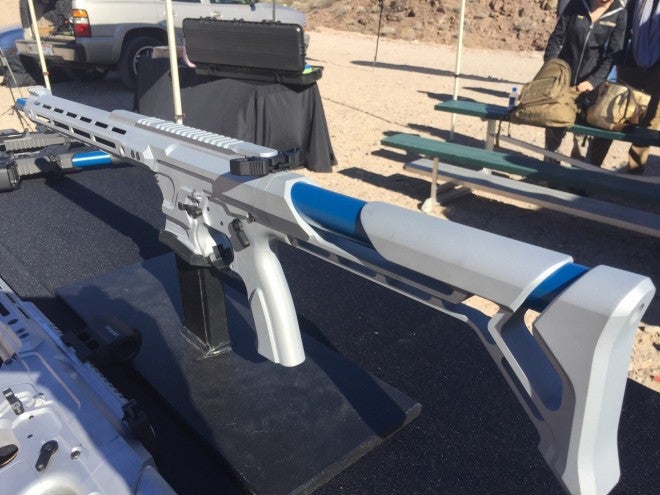
Fixed stock semi auto.
On the other hand, if you want a super distinctive rifle, that not only has the looks, but also has some interesting, and pretty impressive, design changes, I would recommend giving them a try. If you are interested in features that increase the overall reliability of operation, speed of operations, and ability to deal with malfunctions, I would recommend giving them a try. And if you encounter one in the wild, give it try–it is something you need to fondle to understand and fully appreciate, methinks.
While the platform still has a couple of minor issues to work out (mainly with regard to the loose tolerances in the manufacturing of common magazines), I think they are well on their way to a platform that actually does change the AR platform for the better. Their design philosophy and engineering philosophy is also important—they are very agile in implementation and willing to take design risks.
In a world where the newest innovation is a change to the color of your polymer, Cobalt Kinetics stands out as a company willing to try something new to bring a better product to the market.
One other thing to note: they did mention that there are going to be some super “secret squirrel” things that they will also be bringing to SHOT this year (that were not ready for this demonstration). Stay tuned to see what else their engineering elves have created…
You can follow their Instagram account to see more pics and videos: https://www.instagram.com/cobaltkinetics/
 Your Privacy Choices
Your Privacy Choices
